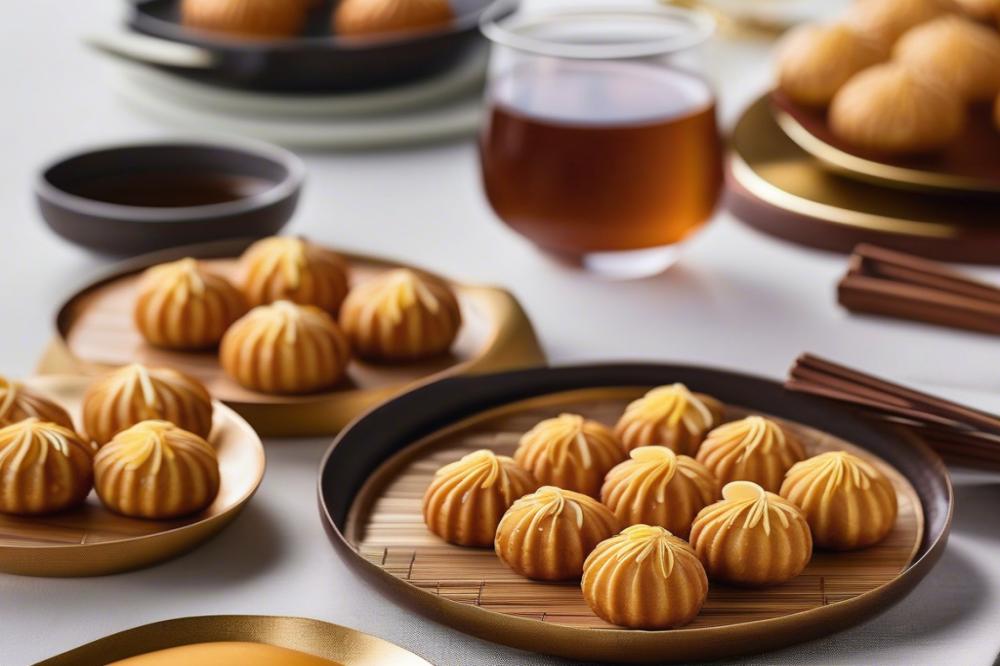Introduction
Hodu Gwaja is a beloved classic in the realm of Korean desserts. This delightful walnut pastry showcases the rich flavors found in traditional snacks of the region. It perfectly reflects the balance of textures and tastes that defines much of Korean cuisine. Notably, these pastries boast a crunchy exterior while harboring a soft, sweet interior filled with ground walnuts.
The significance of Hodu Gwaja extends beyond its delicious taste. In the bustling streets of South Korea, these treats play an essential role in the vibrant street food scene. Vendors sell them hot and fresh, attracting eager customers with the tempting aroma that fills the air. Enjoying this savory-sweet treat is often associated with warm memories and shared experiences among friends and family.
When it comes to flavor, a bite reveals the delightful combination of nutty undertones and a hint of sweetness. Many people crave these easy desserts for their satisfying taste. They often serve as an excellent introduction to the world of Korean baking recipes. For lovers of desserts and street food alike, Hodu Gwaja offers a taste of Korean culture that is both rich and inviting.
Hodu Gwaja: The Delightful Walnut Pastry


Hodu Gwaja is a beloved Korean dessert that features a rich filling of walnuts and sweetened red bean paste. This pastry has a soft, fluffy exterior that contrasts beautifully with its nutty and sweet interior. Known for its distinct shape resembling a walnut, it is not only pleasant to consume but also visually appealing.
Historical Context and Significance in Korean Cuisine
The history of this pastry dates back to the 1930s. During this time, a local bakery in the city of Suwon began selling them. As word spread, they quickly became popular among people. Today, they are a staple in Korean street food culture. Many enjoy these tasty treats during festivals or as snacks during family gatherings. Their significance extends beyond just being food; Hodu Gwaja represents comfort and nostalgia in many households.
Comparison with Other Traditional Korean Snacks
When looking at other traditional snacks in Korean cuisine, Hodu Gwaja stands out. For example, while hotteok is also sweet, it features a different texture and flavor profile. Similarly, rice cakes are common but do not usually contain nuts. Many Korean desserts tend to have savory-sweet combinations that might surprise first-time tasters. The delightful contrast of flavors makes Hodu Gwaja a sought-after option among various easy desserts. Bakers and snack lovers alike embrace the joy of trying to recreate this walnut pastry, adding their unique spins on classic recipes. It fits perfectly as a savory-sweet treat on any dessert guide.
Ingredients List and Cooking Instructions


Complete List of Ingredients
For this scrumptious walnut pastry, you will need the following:
- 1 cup of all-purpose flour
- 1/2 cup of glutinous rice flour
- 1/4 cup of powdered sugar
- 1/2 cup of water
- 1/2 teaspoon of baking powder
- 1/4 teaspoon of salt
- 1 cup of finely chopped walnuts
- 1/2 cup of brown sugar
- 1 tablespoon of vegetable oil
- 1 teaspoon of honey
Step-by-Step Method for Preparation and Baking
Start by preheating your oven to 350°F (175°C). Combine the all-purpose flour, glutinous rice flour, powdered sugar, baking powder, and salt in a mixing bowl. Stir these dry ingredients well to eliminate any lumps. Gradually add water while mixing until you form a smooth dough. Let it rest for about 20 minutes.
In another bowl, mix chopped walnuts and brown sugar. This filling provides that crunchy and sweet touch. Mix in the vegetable oil and honey to enhance the flavor. Take a small ball of the dough and flatten it in your palm. Add a spoonful of the walnut mixture into the center and fold the dough over it. Make sure to seal it tightly.
Place the filled pastries on a greased baking sheet, spacing them evenly. Bake in the preheated oven for 20-25 minutes. Keep an eye on them. They should turn a lovely golden brown when ready.
Tips for Achieving the Perfect Texture and Flavor
Using fresh walnuts is essential for the best taste. If you like toasted nuts, consider toasting them slightly before adding into the filling. Adjust the amount of brown sugar based on your taste preference. For a deeper flavor, add a pinch of cinnamon or a dash of vanilla extract to the filling. Let the pastries cool before serving, which helps them firm up and enhances their flavor.
Nutritional Information for Each Ingredient
Understanding the nutrients can help appreciate this traditional snack even more. All-purpose flour has carbohydrates, providing energy. Glutinous rice flour adds a chewy texture and some fiber. Powdered sugar contributes sweetness but lacks nutrients. Water is crucial for hydration. Baking powder aids in rising, while salt enhances overall flavor.
Walnuts are packed with healthy fats, protein, and omega-3 fatty acids. Brown sugar offers some minerals but is still high in calories. Vegetable oil gives moisture while providing healthy fats. Lastly, honey adds natural sweetness along with antibacterial properties. Each ingredient plays a role in both nutrition and the delightful taste of this savory-sweet treat.
Exploring Variations of Hodu Gwaja


Korean desserts showcase a rich tapestry of flavors and textures. Hodu Gwaja’s origins are rooted in different regions of Korea, with each area boasting its own twist on this beloved walnut pastry. For instance, in some coastal cities, local variations are infused with hints of sea salt and sesame oil. These adjustments not only highlight local ingredients but also reflect the diverse nature of Korean cuisine.
Filling alternatives can add excitement to this traditional snack. While sweet red bean paste is the classic choice, some people enjoy a mixture of chestnuts or even sweet potato. Incorporating fruit fillings such as apple or pear introduces a refreshing contrast, transforming the savory-sweet treats into delightful surprises. For those who love a little kick, a spicy cinnamon filling adds a warming touch.
Seasonal Adaptations and Fusion Twists
Adapting recipes to the seasons can breathe new life into the process of baking. In the fall, pumpkin can be blended into the filling, creating a charming autumnal flavor. During cherry blossom season, consider adding cherry extract to capture the essence of spring. These variations resonate with people seeking easy desserts that reflect the time of year.
Fusion twists also present an exciting avenue for culinary exploration. Imagine mixing in chocolate chips for a decadent treat or using matcha powder to enhance color and flavor. Many bakers are blending elements from other cuisines, combining Hodu Gwaja with Western pastry techniques. This approach showcases a creative intersection in food culture that appeals to a wide audience.
As you explore these variations, it’s clear that Hodu Gwaja offers something for everyone. Whether you stick to the classic recipe or venture into new territory, each option creates a delicious experience. This dessert guide can inspire many bakers to join the fun and make their own unique creations.
Serving and Enjoying Hodu Gwaja


Best Ways to Serve and Presentation Ideas
Serving this delightful walnut pastry can be an experience in itself. Consider placing the treats on a decorative plate that showcases their golden-brown color. Adding a light dusting of powdered sugar can enhance their visual appeal. For a pop of color, serve them alongside fresh fruits like berries or sliced kiwi. Arrange them in groups for a casual gathering or present them individually in small paper cups for more formal settings. Using vibrant dishware can bring out the deliciousness of these savory-sweet treats.
Pairing Suggestions with Beverages or Other Korean Desserts
Beverage pairings can greatly enhance the enjoyment of these pastries. For instance, a hot cup of traditional Korean tea, such as barley tea, complements the flavors nicely. If you prefer something sweeter, try serving them with a glass of sweetened milk or Korean iced coffee. These pastries also pair well with other Korean desserts. Think of pairing them with red bean cakes or rice cakes. Exploring these combinations can make your dessert spread more exciting and varied.
Cultural Etiquette and Significance of Sharing These Treats
Sharing food holds a special place in Korean culture. When offering pastries like this walnut treat, always be sure to offer them to others first. It shows respect and hospitality. Sharing enhances the experience while fostering connections among family and friends. This tradition is especially significant during gatherings or celebrations. Enjoying these easy desserts together creates joyful moments. Understanding and embracing this cultural aspect can deepen your appreciation of Korean cuisine and food culture.
Wrapping Up the Delightful Journey
Significance in Korean Dessert Culture
Korea boasts a rich tapestry of flavors, and walnut pastry is a cherished element of its dessert culture. Enjoyed during celebrations and as a comforting treat, this sweet delight holds a special place in many hearts. Bringing together crispy outer layers and warm, nutty filling, it creates a memorable experience for anyone who tastes it. Food often carries stories, and this pastry is no exception.
Encouragement to Make it at Home
Have you ever thought about trying your hand at making this delicious treat? Preparing it in your kitchen can be a rewarding experience. The process allows you to embrace the delightful aromas and flavors of Korean desserts. You might find joy in mastering the technique and sharing your creations with family and friends. It could be a fun activity to explore with loved ones.
Explore More Baking Adventures
Dive into the world of Korean baking recipes to continue your culinary journey. Many other delightful pastries and desserts await your discovery. From traditional treats to modern interpretations, there’s much to explore. Each recipe you try will add to your skills and appreciation for this vibrant cuisine. Why not start today?



